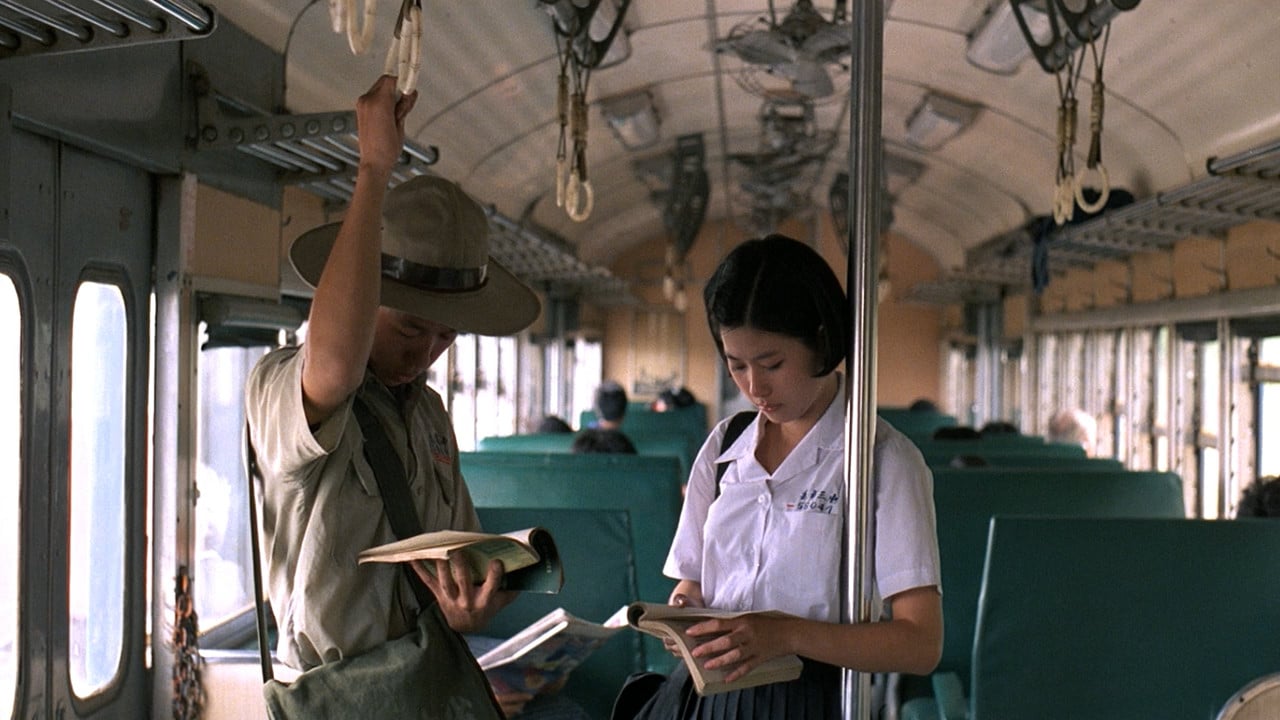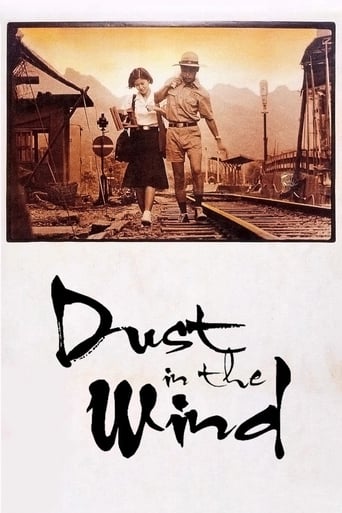Jeanskynebu
the audience applauded
BroadcastChic
Excellent, a Must See
Brendon Jones
It’s fine. It's literally the definition of a fine movie. You’ve seen it before, you know every beat and outcome before the characters even do. Only question is how much escapism you’re looking for.
Nicole
I enjoyed watching this film and would recommend other to give it a try , (as I am) but this movie, although enjoyable to watch due to the better than average acting fails to add anything new to its storyline that is all too familiar to these types of movies.
Pierre Radulescu
The screen is totally black and after a few moments a very unclear spot seems to flicker in the middle; just a few more moments and the tiny white spot gets clear; the spot gets bigger: it's the end of a railroad tunnel, and a train is running through the mountains. The movie has just started.Made in 1986, Dust in the Wind belongs to the first artistic decade of Hou Hsiao-Hsien. This was a period when the Taiwanese director was preoccupied by the story of his own generation: the youngsters from the sixties, coming to age while their country was coming to age. Teenagers leaving the countryside for the big cities, facing the challenges of an unknown environment, trying to understand the new realities and to adapt, while still reluctant. Youngsters behaving erratically, like dust in the wind, dreaming big, till confronted by time and fate: time to erode all illusions, fate to treat all dreams like dust in the wind.Nothing remarkable happens in this movie. You can consider the plot as extremely boring, only this is not the point. Also some reviewers stressed out the unsentimental approach of the director in telling a story that after all implies sentiments. It's true, but again, this is not the point. Like in all films of Hou Hsiao-Hsien, the plot has the unique role to create a universe, and to leave room for meditation. The language of images is here essential, to operate on the subconscious level. Watching Dust in the Wind calls immediately in mind the world from the movies of De Sica, but the Taiwanese master gets subtly beyond. It's just amazing how this director takes the sordid (in good neorealist tradition), finds the perfect place for each actor, for each object, and processes everything in hypnotic long takes.The influence of Ozu is also present in this movie (let away the same love for railroad scenes, think at the last scene, showing the ocean: it's the moment of stasis, the way all Ozu's works end; coming immediately after the dramatic outcome of the plot, it suggests that whatever happens is unimportant in the cosmic order of things; life will go on anyway). What differentiates Ozu and Hou is the way they treat the plot. If you watch any movie created by Ozu, you have the feeling that the Japanese master is seated near you, enjoying the events from the screen as much as you do. For Hou the story is like an executive summary, detailed just to the point where the images can exist on their own to play on the hypnotic register.I found Dust in the Wind on youTube, in ten consecutive videos. I know that watching a movie by Hou Hsiao-Hsien on youTube can be painful, so I suggest you get a DVD copy, if possible. I watched it on youTube, and my Internet connection was getting slower every now and then. However it paid.
maksquibs
Hsaio-hsien Hou based this quietly effective Taiwanese Bildungrsoman on co-scripter Nien-Jen Wu's own experiences. The film is heavily influenced on the one side from Japanese masters like Ozu (though Hou denies this) and from the Italian Neo-Realists whose films inspired Wu. It's the old story of the younger generation ('60s kids from a mining town) leaving the country to try their luck in the big city. A shy, but devoted couple seem to be making a go of it, but life, jobs, family and even military service take a toll on the relationship. It's well observed, especially in the rural sections, and charmingly acted, but the natural flow of events doesn't really stick with you. Hou has trouble balancing the plot strands and particularizing the relationships, asking for a response out of proportion to what we've seen. No doubt this is not a problem for Taiwanese audiences, but then Ozu & De Sica managed the trick, didn't they.
Raúl Quintanilla Alvarado
When it comes to writing about a specific film I stutter, I'm lost. But don't misunderstand me, I know enough of movies to say this is a work of art that will prevail thorough time as the greatest novels do. I believe Hou is up there with Tarkovsky, Bresson, Ozu, Pasolini, Dreyer, Sokurov, Fellini, Herzog, Paradjanov and others. I mention them so as to locate a few of you readers who may have heard little of Hou.I think its better not to talk about the movie itself, one shall see it with new eyes. It is something new, this time cinema works for reality to transform it to beauty, that's the real meaning of art. It may seem simple at times, and yes it is, for time at present seems always simple, but it also accumulates the most complex structure of time. One can feel how the banality of everyday slowly fixates itself in eternity, one can see the inevitable, the beauty in the every small detail. Hou justifies life in a century that has lost itself and that sees only its own shadow. Humanity in its true form, going around like lost and innocent children, and there's no evil. And every second in Hou's work makes life more beautiful.I've talked to a few people who have seen his movies, I can't guarantee the same experience, but what I've seen is there if you can see it in yourself.
zetes
SLIGHT SPOILERSHou Hsiao-hsien is a filmmaker whose name has been dropped a thousand times in conversations I've had in the past year. Last week, I had a chance to see A Time to Live and a Time to Die. It was terrible. BUT, it was early in his career, and I was warned that many did not care for it. I can't imagine who would, but apparently there are some on the planet. And, to boot, not that many people had seen it. It is not available on video in the US. Those who alerted me to this filmmaker's existence were thoughtful and intelligent people, so I had no intention on giving up on Hsiao-hsien. This week, I got a chance to see Dust in the Wind. And I liked it. Now, it's nothing to write home about, but, this being, I think, the film he made right after ATtLaTtD, his maturation can be seen quite clearly. The script of Dust in the Wind is much better. When this film began, and I saw the aging but humorous grandfather, the injured and quiet father, and the harsh mother, I figured, oh hell, this Hsiao-hsien guy is such a poor writer that he can't even come up with a different family for his next film. The family of ATtLaTtD consisted of an old grandmother who supplied all the comic relief, a mother who was constantly disciplining her children, and a father who was dying of TB. The only difference in DitW was that the grandfather was actually amusing; the grandmother in the earlier film was simply a nuisance. And, lo and behold, Hsiao-hsien (and his editor) had learned how to edit! ATtLaTtD worked on the assumption that all a movie has to contain to be great is a multitude of long takes. A film can be good if it has a fondness for longer takes (take a look at anything Andrei Tarkovsky's made), but I would say that only a pro should depend on them so heavily. We art-house patrons may like the occasional ten minute take, but those who know their stuff can tell when the director and editor were keeping the takes long simply because they have no imagination. Hollywood style editing has proven itself over and over again and, unless you are a Tarkovsky or an Ozu, forget it, bud. The first scene of DitW is made up of a couple of long takes of 1) a train pushing forward on the tracks (about a three or four minute take) and 2) of the two main characters standing in the train (about a two minute take). The second scene, where grandpa attempts to feed the children, is edited with quick cuts, almost jump cuts, which suggests the old man's mounting frustrations with his disobedient grandchildren (the way in which he gets one grandson to eat his dinner is classic). This is how editing works, and Hsiao-hsien has learned that. Now his ten minute takes are not a burden. They carry more weight. The film also contains its share of truly fantastic scenes, including those opening two that I referenced. Another one involves the two main characters, Wan (the boy) and Huen (the girl), who are dependent on each other and call it love, at a bar with a bunch of friends. The emotions that play out in this scene are fantastic. Wan's friends convince Huen to take her first drink of beer, which she does in one huge gulp, followed closely by a second on her own accord. Then Hsiao-hsien cuts to a shot over Huen's shoulder. A space to her right is left open around the otherwise full table, and, from across the table, Han fills that gap. The shot lasts for some five minutes. Han is angry at Huen, and the emotions are broadcast marvelously, mostly by the way Han smokes, in this composition. The best scene in the movie involves Han's attempts to steal a moped. This was the only scene that truly affected me. At least one scene really bothered me. The visual style of this film is rather bland. And I don't mind that; the genre is neorealism (whether Hsiao-hsien knows that or not; his debts to Vittorio de Sica and Satyajit Ray seem clear enough to me), and the visuals are supposed to look cheap (because, well, these movies are made for very little money). For a film like this, when I say that a shot is well composed, like the bar scene I mentioned above, it is because it is composed in such a way to give the scene its maximum emotional weight. That shot was marvelous not because it was flashy, but because it seemed natural and it was miraculously economical. Now there comes a shot nearer the film's end, after Han is drafted into the army, in which two soldiers are shot at a high angle in silhouette as they stand on top of a hill, bluish storm clouds against a pinkish sky. In a film where naturalism is the goal of every composition, this particular shot stands out like a sore thumb. C'mon, Hou, if you want to emulate Ingmar Bergman, wait until your next film and then style your film in that manner! It's a truly embarrassing shot. I've said nothing about the film's story. Suffice it to say, it is touching, but not too much so. Han is a well developed character, but I felt that I ought to have known Huen more. Her decision near the end of the film comes too quickly and at too great a distance from the action. The audience then has no choice but to make a bitter judgement on her character. We side solely with Han, when we it should be more ambiguous; previously, they had been given rather equal footing in their developments. The final scene is quite beautiful, however, and leaves the audience feeling like they've witnessed something at least somewhat worthwhile. 7/10.

